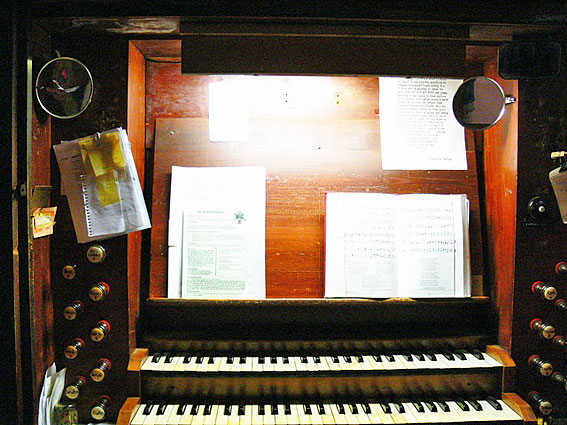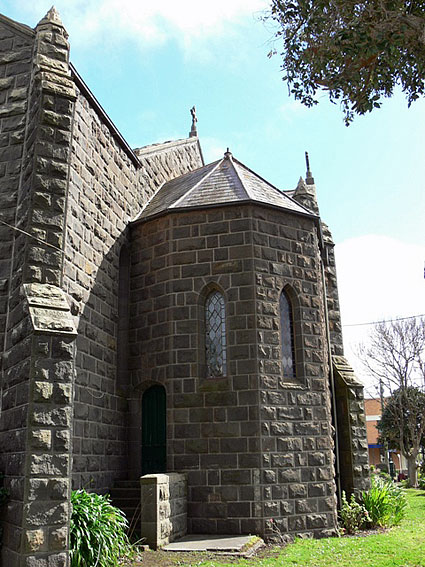St Stephen's Anglican Church
Portland
First organ, B Henry Bevington, London; inst 1842 St James's Church (Old Cathedral), Melbourne;
inst c1872 St Stephen's Church; broken up 1881.
Present organ, B 1881-82 George Fincham,
incorporating some pipework (and case?) from previous organ; ren 1981 Leighton Turner.
2m, 13spst, 3c, tr. Gt: 8.8 divided.8.4.4.2. Sw: 8.8.8.4.2.8. Ped: 16.


The first Anglican services were held in Portland in 1834. Construction of St Stephen’s Church was begun in 1855 to the design of George M. Mathewson and built in bluestone in Early English Gothic idiom; it was opened in 1856. The building was never completed to the original designs and a narthex, designed by Louis R. Williams, was built in 1975-76.
The first pipe organ was the instrument built by H. Bevington & Son, London, that was placed in St James’s Church (later Cathedral), Melbourne in 1842. This single-manual instrument was displaced by a new organ built in 1868 by George Fincham and was sold to Henry J. King, the organist; at this time a Cremona stop was removed and replaced by a Flute, presumably of 4ft pitch – the Cremona was later sold to John Alsop, of Kew for his residence organ.
The Bevington organ was installed at Portland around 1872 and remained there until 1881 when some of the pipework was used in the new organ built by George Fincham under the supervision of Henry Byron Moore; it was opened on 14 March 1882 by Charles Sykes. The structure and remaining pipework of the Bevington organ was discarded – it is possible that some mechanical components may have been acquired by William Anderson and utilised in his instrument of 1882 for St George’s Catholic Church, Carlton, now at Christ Church, Beechworth.
The new organ was initially erected in the body of the church. Shortly afterwards a new bluestone organ chamber, with domed roof decorated in sky blue with gilded stars (decorated by Mr Purvis), at the south-east corner of the church, was erected in the memory of Portland pioneer Edward Henty who arrived in the area on 19 November 1834. The organ was placed there in October 1882, Fincham supplying a flat of dummy pipes to screen the arch facing into the nave. The instrument remains in this position, but sadly the decoration of the dome was painted out after 1994 in white.
The organ remains largely intact and retains its original mechanisms, wind system, casework (possibly incorporating turned columns from the Bevington organ), stencilled façade pipes and internal pipework, some of which survive from the early Bevington organ. These contain a high percentage lead and are readily distinguishable from the spotted metal pipes of George Fincham. The placement of the slotted Gamba at the back of the Swell box would seem to indicate that it may have been a later addition: the drawstop is placed at the top of the Swell jamb and the engraved label differs from the other stops.
In 1981 a renovation was carried out by Leighton Turner, of Ballarat.
GREAT |
8 8 8 8 4 4 2 8 8 4 2 8 8 16 |
CC-BB # TC TC # # # (longest pipes extend beneath swell box) # top metal pipes maybe # |
# Bevington pipework
Compass: 56/30
3 composition pedals to Great
Lever swell pedal
Attached drawstop console
Mechanical key and stop action
Hand blowing
 |
 |
|

|
||
 |
 |
|

|
||

|
||

|
||

|
||
 |
 |
|
 |
 |
|

The two images of the internal pipework were supplied by Mark Fisher,
the remainder, including the photograph taken at the 1994 conference showing the organ chamber
with its splendid atmospheric sky – sadly painted out - supplied by JRM (Oct 2008).
Noel F. Learmonth. The Story of St Stephens: History of St Stephen’s Church of England, Portland. Portland, Vic.: St Stephen’s Vestry, 1956, p.14
Church of England Messenger, 9 February 1917, p.63
Victorian Churches, edited by Miles Lewis. East Melbourne; National Trust of Australia (Victoria), 1991, p.143
E.N. Matthews, Colonial Organs and Organbuilders. Carlton: Melbourne University Press, 1969, pp. 112, 175-76
Bevington pipework identified by Mark Fisher, pers.comm. to John Maidment 13 September 2008
John Maidment
18 October 2008